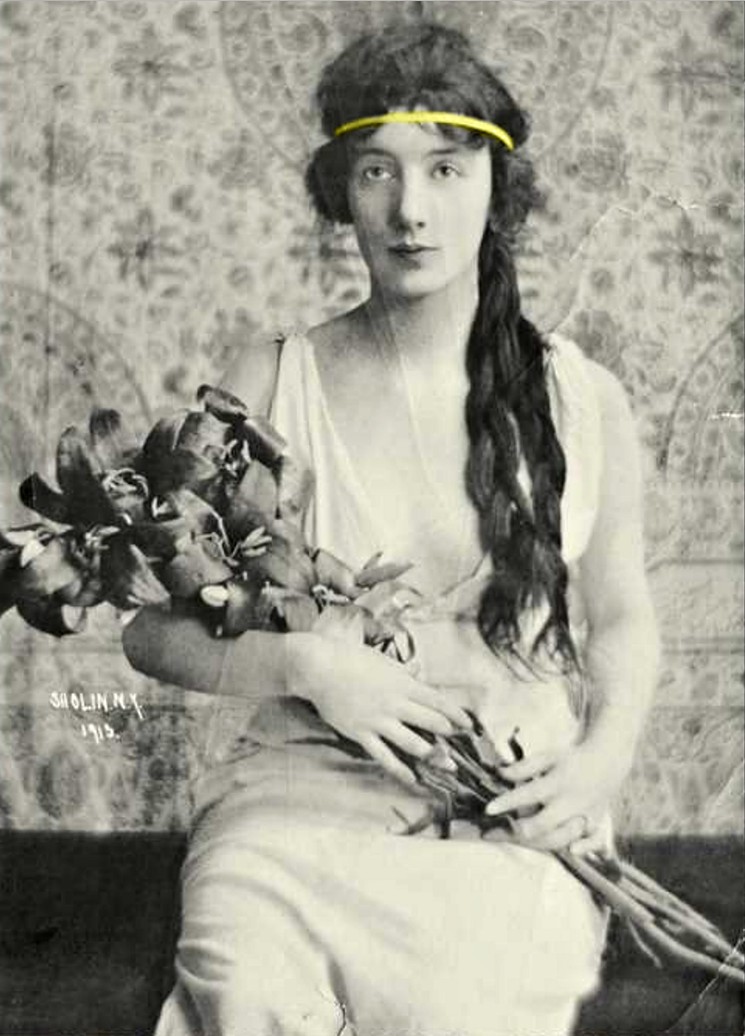Although the sculpture is widely known to be the work of the renowned sculptor Alexander Stirling Calder, the woman whose gentle yet probing stare he chose to immortalize has, for decades, remained a mystery. And because the siren's visage has changed significantly over the past 100 years due to erosion, some have speculated that her identity will never be known.
However, in flipping back the pages of history, several clues hint at the identity of the model for the dissolving mermaid. They all seem to point, with eager fingers, to a woman who was once nicknamed "Miss Manhattan": Audrey Marie Munson.
After being discovered by photographer Ralph Draper when she was about 19 years old, Munson quickly became the muse of artists across Gotham. Intensely funny and blessed with a "Venus physique," she sat for dozens of monumental works.

At the turn of the last century, artists believed lilies were the only flowers suitable to adorn angels.
During Munson's heyday as a muse, news story after news story covered her strange but fabulous life. One article, for example, reveals not only that was she "discovered" by Draper while shopping with her mother (proof that new shoes can change your life), but also that among the many statues she posed for was one of a mermaid.
In the early 1910s, under the artistic vision of Allen George Newman, Munson posed as the mythical creature for a sculpture that was planned to adorn a fountain — called Music of Water — on the Big Apple's Riverside Drive.
The artists' community in New York was small, so Alexander Stirling Calder would have seen, or at least heard the news of, Munson being immortalized as an aquatic siren in The Sun. This is significant because not only was the New York City-based Calder the sculptor of the mermaid at Vizcaya, but also, according to various sources, Munson was his preferred model. Just before he began creating the barge sculpture in 1917, he finished a piece called Star Maiden depicting "Miss Manhattan" in 1915.
"She was indeed [Calder's] favorite," says Gina Wouters, the curator of Vizcaya Museum & Gardens. "[She was] the favorite for many sculptors of the period."
Since Calder would have already seen his favorite muse as a mermaid via newspapers, it's possible he could have been inspired to sculpt her, again, for the grand piece at Vizcaya.
However, there's a more sentimental reason why Calder might have fashioned the mermaid in Munson's visage, and it's attached to a living mystery. Though she modeled for Newman's Music of Water, the project never came to fruition. Worse, the sculpture itself went missing. It appears to be lost to history.
It's possible that after hearing about the canned yet glorious mermaid fountain, Calder could have chiseled the coral rock in Coconut Grove in her image.
"It is entirely possible, but I couldn’t say with certainty," Wouters says of whether the woman in the stone is Munson. She notes that without a historical oral or written statement, it would be difficult to confirm her as the mermaid's muse.
Because the facts of the day repeatedly connect to her, Munson remains the best guess. If she is the muse, the sculpture, which has leant South Florida an aesthetic sensibility for a century, ties New York City and Miami in an epic yet slowly deteriorating way.
Munson lived in New York, but her life story, full of sexy and sordid details, is as Miami as it gets. She was the first "supermodel" in U.S. history. She was also the first woman to appear entirely nude in a film, playing an artist's muse who disrobes during a sitting session in the 1915 movie Inspiration. "I see nothing shocking in our unclothed bodies," Munson said about being seen naked, which was no surprise because New Yorkers had already seen her naked at various intersections and in public parks.
Unfortunately, when you're an It-girl, drama is bound to seep into your life.
During the young model's life, Munson was connected with a savage murder. Reportedly, one of her former landlords was so entranced with her that he murdered his wife so he would be available to be with Miss Manhattan. Though she was cleared of any guilt related to the crime, after the public heard about the grisly case, many people were perturbed by her and looked the other way.
Among the masses were New York artists. Munson's career as a professional muse came to an abrupt end. Her beauty caused people to do crazy, even wicked things, which, in the end, dashed her dreams.
After the murder trial, when she was in her late 30s and no longer the darling of Manhattanites, Munson was placed in a New York mental asylum after attempting suicide. One of the Empire State's most visible figures lived in the hospital until her dying day in 1996, at 104 years old.
Sex, crime, art, mental illness, and old age: That's Miami in a nutshell.
Munson led a fabulous yet tragic life. More than anything, though, she wasn't a bore. It seems Calder chose to immortalize her as a mermaid because, like the mythical sea creature, she was capricious and daring, unafraid to push the envelope, and ready to venture into unchartered social waters for the sake of artistic expression.













